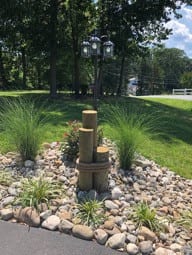Lawn Care Company in Southern MD
What to do about an overfertilized lawn
Landscaping
Lush lawns are not achieved without a lot of hard work. That hard work often involves some trial and error, and one of the simplest errors a person can make is overfertilizing a lawn, explains Sunscape Landscaping, a Lawn Care Company in Southern MD.
Overfertilization is an easy mistake to make, but it's a mistake that can have long-lasting consequences. According to the lawn care experts at Scotts®, overfertilizing a lawn can damage grass. Overfertilized lawns are subject to excessive leaf growth, which may require more maintenance, like extra mowing, in the interim. Over time, an overfertilized lawn can develop a sponge-like feel and may be increasingly vulnerable to fungal disease.
Of course, homeowners can only address an overfertilized lawn after they learn to spot signs that the lawn has been fed too much fertilizer. Brown and patchy grass is one of the telltale signs that a lawn has been overfertilized. This can occur because too much nitrogen has made its way onto the lawn. Scotts® notes that nitrogen greens up grass and helps it grow, but too much nitrogen can scorch the lawn, making it brown and patchy.
Minimal growth after fertilization is another indicator of overfertilization. Some lawns that have been overfertilized may not grow at all afterward.
Blackened or limp grass and crusting of fertilizer on the top of the soil are other symptoms of overfertilization.
When fertilizing a lawn, it's important that homeowners recognize that many products are now slow-release fertilizers. Packaging will indicate if your fertilizer fits this mold, and if it does, don't be surprised if results are not immediate. Slow-release fertilizers can help with lawns where the soil does not drain especially well. Give these fertilizers time to do their job and resist the temptation to apply more fertilizer.
If a lawn has indeed been overfertilized, homeowners can remove any fertilizer they see on top on the soil. Once the fertilizer has been removed, water the lawn heavily, which can wash any remaining residue away. Watering daily in the ensuing days can remove any lingering fertilizer and reduce the likelihood that a lawn will develop issues with fungus.
Fertilizing a lawn involves carefully adhering to manufacturer instructions. If a lawn is overfertilized, removing fertilizer on the soil and heavily watering the lawn can help restore it to health and reduce the risk for disease.

